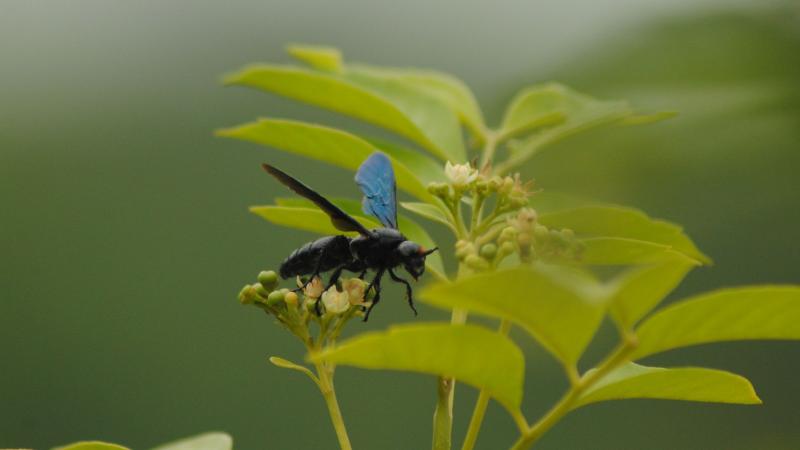
You must be familiar with the X-Men series of films and comic books where Prof. Charles Xavier can read and control other people’s minds. Even if you aren’t, you must have come across the power of mind control being used as a prominent plot device in other media of science fiction or fantasy genre. But would you believe it if someone told you that mind control, or rather behavioural control, is not only a reality but also a phenomenon that we can observe in the animals we see around us?
This is what a recent study on parasitoid wasps is about – unearthing the ability to control or modulate the behaviour of their host species.
Ms. Prabitha Mohan and Dr. Palatty Allesh Sinu studied how the parasitoid wasp Microplitis pennatulae changed the normal behaviour of its host, the larvae of the moth Psalis pennatula, a pest of rice. They found that the moth larva guarded the pupa of its parasitioid by thrashing wildly and swinging its head vigorously against any agent that would endanger the parasitoid pupa.
A parasitoid is an organism similar to a parasite that survives at the expense of a host organism, while contributing nothing to the survival of the host. They both can be specialised to the extent that they only parasitise individuals of a single species.
To study the parasitoid and host relationship, the scientists collected individuals of the host species moth P. pennatula and the parasitoid wasp species M. pennatulae. Another group of insects they collected were those of Brachymeria sp. - wasps that act as parasites on the parasitoid wasp M. pennatulae. The second group of wasps, due to their parasitic activity on a parasitoid, are called hyperparasites and the researchers studied their interaction with the other two species as well.
“Parasitioid-host-hyperparasite relationships are commonly seen in insect systems. Parasitoids are of two types- Koinobiont and Idiobionts. Idiobionts kill or paralyse the host after parsitisation, while koinobionts allow the further development of host larva after parasitisation. In our case, the parasitoid is a Koinobiont”, says Ms Mohan about the parasitoid biology.
In laboratory conditions, the researchers allowed adult male and female moths of P. pennatula to mate, after which the females laid eggs. The caterpillars that emerged from the eggs were transferred to cages where they were provided with their natural diet. Similarly, adult males and females of the parasitoid M. pennatulae were also allowed to mate; and then, those females were provided access to the caterpillars of P. pennatula, inside whose bodies they laid their eggs.
While laying eggs inside other organisms might seem horrific, parasitoids play a very important ecological role. “They check the population of the host. Hyperparasitoids perform a similar function by parasitising on parasitoids. In agriculture, parasitoids are extremely useful in controlling pest population. Mass rearing and release of parasitoids is done for controlling pest population and to reduce economic loss”, remarks Ms. Prabitha.
At the end of about 11-14 days in laboratory conditions, the parasitoid nears completion of its larval stage inside the host caterpillars, so they come out through the sides of the rear end of its host and form a cocoon (pupa) underneath the host. This process in which the parasitoid comes out of the host larva is called egression. During egression, the host appears to be paralysed or unconscious. And interestingly, after egression, the host larvae regain consciousness but stop moving and feeding.
Individuals of Brachymeria sp., the parasitic wasp species which acts as hyperparasites on M. pennatulae were introduced to the parasitoid pupae in two different situations; one in which the pupae were guarded the host larvae, and another in which the pupae were unguarded, having been removed from the host larvae.
It was found that while Brachymeria was able to parasitise all the unguarded pupae, the hyperparasite could parasitise only 6 out of 20 guarded pupae. This was because of the defensive behaviour exhibited by the host larvae after egression, which involved vigorous head swinging and thrashing of the body.
The researchers then compared the behaviour seen in the parasitised host larvae before and after egression, with that of unparasitised host larvae of the same age group and size. They used walking, feeding rate and defensive behaviour as three parameters for comparison. Parasitised and unparasitised host larvae exhibited similar rates of movement and feeding. After egression, however, the parasitised larvae stopped feeding and walking, and showed defensive behaviour involving head swinging and body thrashing.
All these clearly point to M. pennatulae as the culprit behind the bodyguard manipulation and highlighting that this behaviour was only seen post egression, Ms. Prabitha says, “So it was obvious that these changes in the behaviour of the parasitised host larvae were not developed gradually, but were materialised abruptly after egression of the parasitoid.”
The researchers hypothesise that these behavioural changes are induced in the host larvae by the parasitoid to guard its offspring. And in this, the parasitoid seems to have succeeded to a great extent.
But the researchers also believe that the parasitoid may not be directly responsible for the induced behavioural changes. Studies on other parasitic wasps suggest that a virus might be the agent responsible for this. Ms. Prabitha concludes by saying, “Till now we don’t have any evidence on the presence of virus in P. pennatula, but we are working on it. Previous articles published on this topic indicate a chance for that”.
